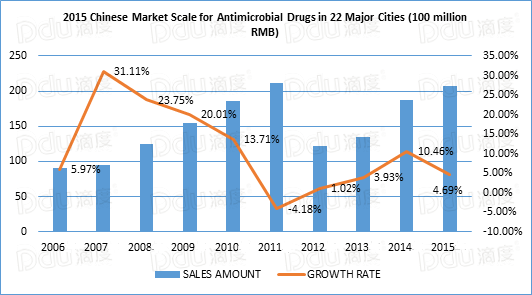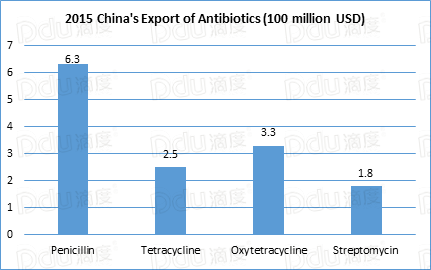China’s Antimicrobial Drug Import and Export Market Report
October 13, 2017
Source: Ddu
 1,841
1,841

"Antimicrobial" is a general term which refers to a group of drugs that includes antibiotics, antifungals, antiprotozoals and antivirals, which are destructive or have inhibiting effect to bacteria, fungi and chlamydia and is one of the most widely used drugs in clinical trials.
Today, Ddu, the leading global pharmaceutical & medical device B2B online platform, brings you the breakdowns on China’s Antimicrobial Drug Import and Export Market Report.
1. General situation of global antimicrobial drug market
At present, the global antimicrobial drug market is relatively mature, accounting for 15% of universal drug market shares. What’s more, antibiotics account for the largest share of the global antimicrobial market with antiviral drugs ranking second followed by antifungals.
To be more specific, amoxicillin sales came out on top followed by augmentin.Amoxicillin, from world-famous pharmaceutical company GlaxoSmithKline (UK), remains to be the best-selling drug in the world.
Antiviral drugs are mainly divided into anti-hepatitis virus drugs, anti-venom virus drugs, influenza virus drugs and anti-respiratory virus drugs, with a major market distribution in North America, Europe, Africa and Asia. The world's largest antiviral market is the United States.
In the global market of antifungal drugs, triazole drugs sell well. Triazole antifungal drugs used for clinical treatments are mainly voriconazole, fluconazole, itraconazole and posaconazole. Voriconazole and fluconazole, developed by the Pfizer(US), are deemed to be very important anti-fungal drugs.

Due to price reductions, new drugs and the enhancement of drug resistance, the growth rate of anti-fungal drugs slowed down with an annual increase of 5%. According to the statistics of WHO, market sales of anti-fungal drugs were 10.86 billion in 2015, of which the most widely used were penicillins and cephalosporins, quinolones and macrolide drugs.
2. General situation of antimicrobial drugs in domesticmarket
Despite slower growth in sales rates of the anti-fungal drugs market, anti-fungal drugs are still the most widely used drugs in clinical treatments in developing countries and still maintain a high-speed growth rate.

According to the China Reports Hall, China's anti-microbial drug market reached 211.9 billion Yuan with a year-on-year increase of 8.4% in 2015. At this rate, it is estimated to exceed over 300 billion Yuan by the year 2020.

With the improvement of living standards, medical security systems, growing treatment rates and full implementation of new health care reform, the antimicrobial market of China's 22 major cities’ sample hospitals exceeded more than 20 billion Yuan, reaching 2.255 billion Yuan in 2015 with an increase of 4.69% over the previous year.
3. China is a big producer of antibiotics with a steady demand for export of penicillin
Europe, South Asia and the United States have been China's three major export markets of antibiotics. The country’s other export markets include Africa, South America, Southeast Asia, Canada and Oceania with the main export products being penicillin, tetracycline, oxytetracycline and streptomycin.
Penicillin was the world's first antibiotic applied in clinical trials. For a long time, penicillin was the top selling product in the antibiotics market and was widely used as a first-line antimicrobial drug throughout the world. In China, penicillin is a heavyweight product in the pharmaceutical industry with the greatest production among antibiotics.

As one of the world's major suppliers of penicillin, China's export sales in 2015 reached 630 million USD. With the rapid development of the penicillin industry, production of China's other three fermented antibiotic products (tetracycline, oxytetracycline and streptomycin) also experienced the same high-speed growth in 2015 with export sales totaling 250 million USD, 330 million USD and 180 million USD respectively.
4. China is a big consumer of antibiotics, expending half of all antibiotics produced worldwide
China is not only a big producer of antibiotics but also a big consumer. According to the statistics of World Health Organization, China consumed half of all antibiotics in the world in 2016 (about 162,000 tons, 91.55 billion USD). In addition to those produced for its own use, China also imports antibiotic, mainly from the USA, Japan and Korea.

According to HDM, 50.4% of the antibiotics in China were imported from Merck Sharp & Dohme (USA), Sumitomo Chemica (Japan), Yungjin Pharm (Korea) and JW Pharmaceutical (Korea). The imported products were carbapenem antibiotics like meropenem, biapenem and etapenem.
The statistics of China’s customs showed that the amounts of imported meropenem, biapenem and etapenem were 11.9 billion USD, 9.8 billion USD, 10.2 billion USD respectively.
5. Leading companies of antimicrobials
- Livzon Pharmaceutical Group Inc.

One of the top twenty listed pharmaceutical companies in China with a world-class modern pharmaceutical manufacturing base up to the standards of the FDA and EU.
Main antimicrobial drug: antibiotics
- Shangdong Qilu King-Phar Pharmaceutical Co., Ltd.
![]()
Being the biopharmaceutical manufacturing base invested by Qilu Pharmaceutical Co.,Ltd with approvals from the FDA, EDQM, and APVMA, Shangdong Qilu King-Phar Pharmaceutical Co., Ltd mainly produces antimicrobial drugs and exports them to more than 30 countries and regions in North America, South America, Europe, the Middle East and Southeast Asia.
Main antimicrobial drugs: neomycin, gentamicin, micronomicin.
- Qilu Pharmaceutical Co., Ltd.
![]()
Qilu Pharmaceutical Co.,Ltd is a large-scale comprehensive modern pharmaceutical company in China with world-leading production capacities. Many of its formulations have been granted approval from drug regulator administrations in the United States, the European Union, Australia, the United Kingdom, South Africa and other countries and regions.
Main antimicrobial drugs: antibiotics
6. There is a promising future for export of gentamicin
Gentamicin is a representative product of aminoglycosides in antibiotics and has been well received by global antimicrobial companies. So far there are only six antimicrobial drugs that have secured FDA approval for clinical use, they are: gentamicin, tobramycin, streptomycin, neomycin, amikacin and paromycin. Gentamicin, amikacin and tobramycin are mostly used to treat systemic infections by American clinicians.
In some western countries such as the United States and Austrailia, gentamicin-based aminoglycoside antibiotics are not only used for clinical treatments but also as veterinary drugs. In Europe and Oceania, where animal husbandry is well developed, they are often used as feed additives which ensures stable sales in the international market.
A great demand for feed additive containing gentamicin and a steady need for medical used gentamicin has developed in recent years. For this reason, Ddu, the leading global pharmaceutical & medical device B2B online platform, believes that there is a promising future for the export of gentamicin.
By DduRead more on
- China’s Import and Export Market Report of Vitamins August 26, 2021
- China’s Import and Export Market Report of Rheumatoid Arthritis Drugs August 26, 2021
- What’s Driving the Global Surgical Robotics Market February 26, 2018
- Ddu College–China’s Import and Export Market Report of Antiallergic Drugs December 1, 2017
- Brief Report on Exports of Chinese Vaccines in the First Three Quarters of 2017 November 27, 2017
your submission has already been received.
OK
Subscribe
Please enter a valid Email address!
Submit
The most relevant industry news & insight will be sent to you every two weeks.



